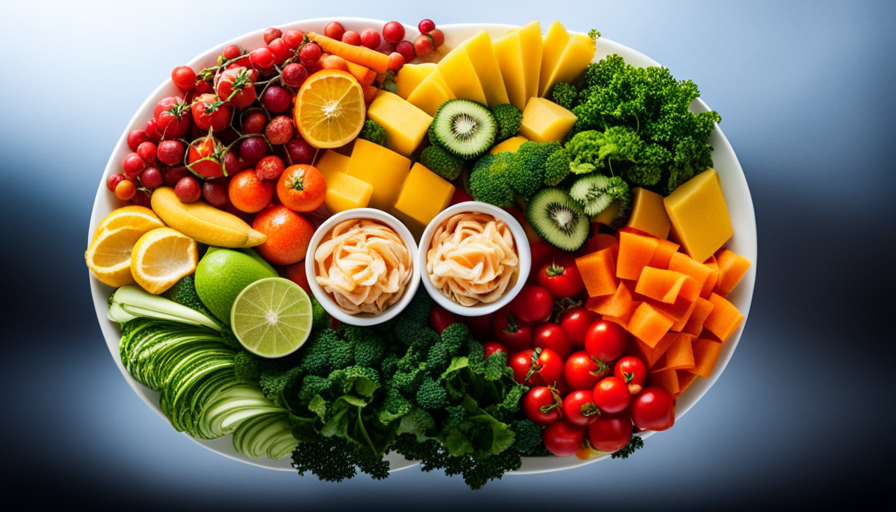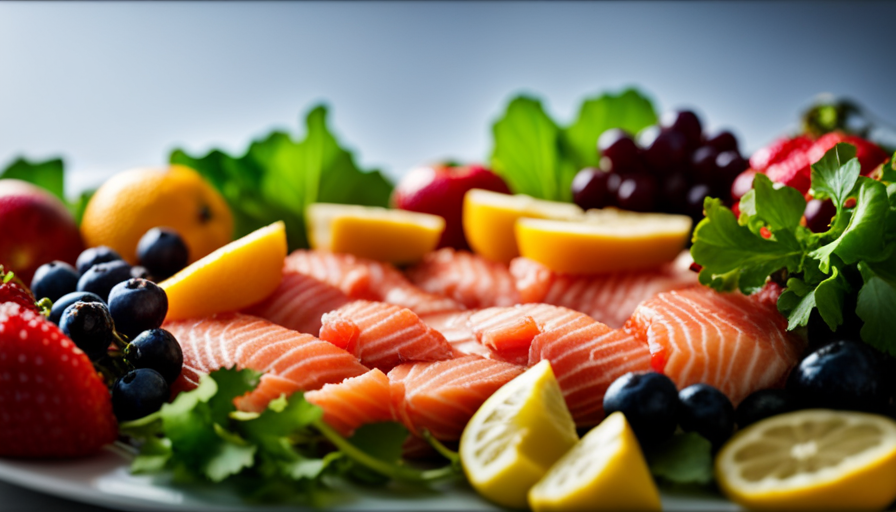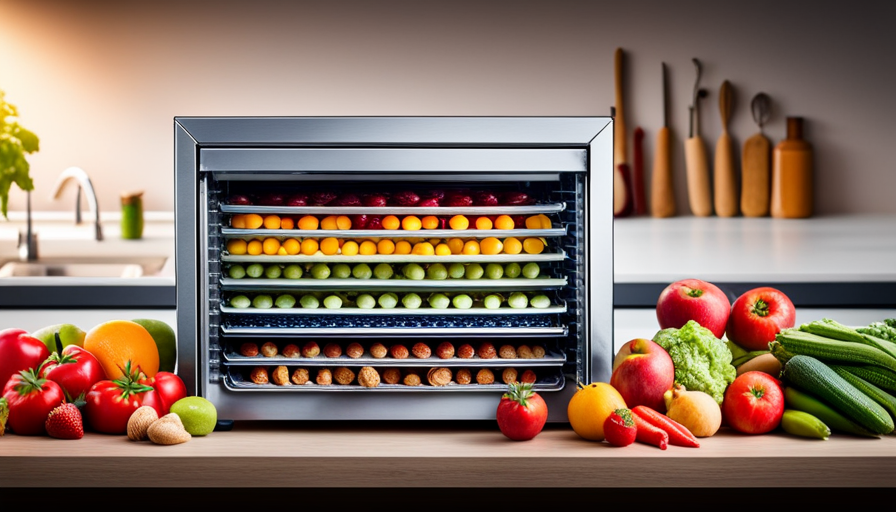The raw food diet is becoming increasingly popular among health-conscious individuals, with 30% of Americans having tried or expressing interest in trying it, according to a recent survey.
If you’re curious about this lifestyle and want to learn how to incorporate more raw foods into your diet, you’ve come to the right place. In this article, we’ll guide you through the ins and outs of eating a raw food diet, providing you with evidence-based information and practical tips to help you get started.
From understanding the health benefits of a raw food diet to stocking your kitchen with the essentials, we’ll cover it all. Whether you’re looking to boost your energy levels, improve digestion, or simply try something new, the raw food diet may be worth exploring.
So, let’s dive in and discover the world of raw food together!
Key Takeaways
- Transition to a raw food diet gradually and consult with a healthcare professional before making significant dietary changes.
- Incorporate more raw fruits and vegetables into meals to increase nutrient intake and antioxidants.
- Include raw nuts, seeds, and grains for healthy fats, protein, fiber, and essential vitamins and minerals.
- Enjoy guilt-free raw food desserts and sweet treats, such as raw smoothies, ice cream, and raw energy bars or balls.
Understanding the Raw Food Lifestyle
If you’re ready to dive into the raw food lifestyle, you’ll need to understand the ins and outs of this transformative way of eating. The raw food diet is all about consuming unprocessed, uncooked foods that are rich in nutrients and enzymes. Advocates claim that this diet can provide numerous benefits for your health, including weight loss, increased energy levels, improved digestion, and a reduced risk of chronic diseases.
One of the main benefits of the raw food diet is that it preserves the natural enzymes present in raw foods. Enzymes play a crucial role in digestion and nutrient absorption, so consuming raw foods can enhance these processes. Additionally, raw foods are typically low in calories and high in fiber, which can aid in weight management.
However, it’s important to be aware of the challenges that come with the raw food lifestyle. One of the main concerns is ensuring adequate nutrient intake, as some nutrients are more easily absorbed when foods are cooked. It’s essential to plan meals carefully to ensure you’re getting all the necessary vitamins, minerals, and protein.
Furthermore, the raw food diet can be restrictive and may require significant effort and planning. It may also be challenging to find raw food options when dining out or traveling. Additionally, some individuals may experience difficulty adjusting to the raw food diet, as it can cause temporary digestive discomfort due to the increased fiber intake.
The raw food diet offers numerous benefits but also presents challenges. Understanding these aspects is crucial before embarking on this transformative way of eating.
Exploring the Health Benefits of a Raw Food Diet
Indulging in this unconventional culinary lifestyle, you’ll discover a treasure trove of vibrant health benefits that’ll leave your taste buds begging for more.
Exploring the nutritional benefits of a raw food diet can open your eyes to a world of improved well-being. Let’s debunk some common misconceptions and delve into the evidence-based advantages of this unique way of eating.
-
Increased nutrient intake: Raw foods are rich in essential vitamins, minerals, and enzymes that can be lost through cooking. By consuming them raw, you maximize your nutrient intake and support optimal health.
-
Enhanced digestion: Raw foods are naturally high in fiber, which aids in digestion and keeps your gut healthy. This can lead to improved bowel movements and a reduced risk of digestive disorders.
-
Weight management: The high fiber content in raw foods helps you feel full for longer, reducing the likelihood of overeating. Additionally, raw foods are typically lower in calories and fat, making them an excellent choice for weight management.
-
Boosted energy levels: Raw foods provide a natural source of energy due to their high nutrient content. Many individuals report increased energy levels and improved focus when following a raw food diet.
By incorporating more raw foods into your diet, you can experience these incredible health benefits. Remember, it’s essential to consult with a healthcare professional or registered dietitian before making any significant dietary changes.
Transitioning to a Raw Food Diet: Getting Started
Ready to embark on a transformative journey towards vibrant health? Ease into the world of raw cuisine by taking the first steps towards transitioning to a raw food lifestyle.
Transitioning to a raw food diet can seem intimidating at first, but with the right tips and resources, it can be a smooth and enjoyable process.
One of the most important tips for transitioning to a raw food diet is to start gradually. Begin by incorporating more raw fruits and vegetables into your meals and gradually increase the amount over time. This will give your body time to adjust and prevent any digestive discomfort.
Finding raw food recipes is another key aspect of transitioning to a raw food diet. There are numerous resources available online, such as raw food blogs and recipe websites, where you can find delicious and creative recipes to try. Experiment with different flavors and textures to keep your meals interesting and satisfying.
Additionally, it can be helpful to join a raw food community or support group. Connecting with others who are on a similar journey can provide you with guidance, inspiration, and a sense of belonging.
Remember, transitioning to a raw food diet is a personal process, and it’s important to listen to your body’s needs and make adjustments accordingly. With patience, persistence, and a willingness to explore new flavors and recipes, you can successfully transition to a raw food lifestyle and experience the many benefits it has to offer.
Stocking Your Kitchen with Raw Food Essentials
When stocking your kitchen with essential ingredients for a raw food lifestyle, make sure to have a variety of fresh fruits and vegetables, nuts and seeds, and high-quality oils and spices on hand. These raw food pantry essentials will provide you with the necessary nutrients and flavors to create delicious and nutritious meals.
In addition to these ingredients, it is also important to have the right tools in your raw food kitchen. Here is a list of raw food kitchen tools that can help you prepare your meals with ease:
| Raw Food Pantry Essentials | Raw Food Kitchen Tools |
|---|---|
| Fresh fruits and vegetables | Blender |
| Nuts and seeds | Food processor |
| High-quality oils | Spiralizer |
| Spices | Dehydrator |
| Mandoline slicer |
Having a blender and a food processor will allow you to create smoothies, sauces, and dips. A spiralizer is useful for making noodles out of vegetables, while a dehydrator can be used to make raw snacks like kale chips and fruit leather. A mandoline slicer will help you achieve thin, even slices of fruits and vegetables for salads and other dishes.
By stocking your kitchen with these raw food pantry essentials and having the right tools, you’ll be well-equipped to embrace a raw food diet and enjoy its many benefits.
The Importance of Proper Food Preparation and Safety
Make sure you properly handle and prepare your ingredients to ensure the safety and quality of your meals. Proper food preparation and safety are crucial when following a raw food diet. Here are three important steps to keep in mind:
-
Wash your produce thoroughly: One of the key aspects of proper food preparation is washing your fruits and vegetables. Even if you buy organic produce, it’s essential to remove any dirt, bacteria, or pesticides that may be present. Use clean water and a vegetable brush to scrub your produce before consuming or preparing it.
-
Store food properly: Raw food can be more susceptible to spoilage and contamination, so it’s important to store it correctly. Keep perishable items, like fruits and vegetables, in the refrigerator to maintain their freshness and prevent the growth of harmful bacteria. Use airtight containers or wraps to prevent cross-contamination and maintain the quality of your ingredients.
-
Avoid cross-contamination: Cross-contamination occurs when bacteria from one food item is transferred to another, potentially leading to foodborne illnesses. To prevent this, use separate cutting boards, knives, and utensils for different food groups, such as fruits, vegetables, and meats. Clean and sanitize your tools thoroughly before and after each use.
By following these proper food preparation and safety practices, you can enjoy the benefits of a raw food diet while minimizing the risk of foodborne illnesses.
Incorporating Raw Fruits and Vegetables into Your Meals
Including fresh fruits and vegetables in your meals adds vibrant colors, flavors, and nutrients to your plate. Not only do they provide essential vitamins and minerals, but they also contain antioxidants that help protect your body against diseases. Incorporating raw fruits and vegetables into your meals can be both delicious and nutritious.
One way to include raw fruits and vegetables is by making raw food smoothies. These smoothies provide a convenient way to consume a variety of fruits and vegetables in one go. You can experiment with different combinations to find your favorite flavors. For example, try blending spinach, kale, banana, and pineapple for a refreshing green smoothie.
Another creative way to incorporate raw vegetables into your meals is by using them as a base for salads or wraps. Instead of using traditional lettuce, try using thinly sliced cucumbers or collard greens as a wrap for your favorite fillings. You can also spiralize zucchini or carrots to create vegetable noodles and top them with your favorite sauce for a healthy and satisfying meal.
By incorporating raw fruits and vegetables into your meals, you can enjoy the benefits of a raw food diet while still having a variety of tasty options available. So go ahead and get creative with your recipes, and enjoy the colorful and nutritious journey!
| 😊 | 🍎 | 🥕 | 🥦 |
| ❤️ | 🍇 | 🍅 | 🥬 |
| 🌈 | 🍓 | 🌽 | 🍆 |
| 🌿 | 🍊 | 🌶️ | 🥒 |
Incorporating Raw Nuts, Seeds, and Grains into Your Diet
Indulge in the crunchy goodness of raw nuts, seeds, and grains, and let your taste buds dance with delight as you discover the hidden treasures of nature’s pantry.
Incorporating raw nuts, seeds, and grains into your raw food diet can provide a variety of health benefits. Raw nuts are a great source of healthy fats, protein, fiber, and essential vitamins and minerals. They can be enjoyed on their own as a snack or incorporated into various recipes. For example, you can make a delicious raw nut milk by blending soaked nuts with water and sweeteners like dates or honey. Raw nut butters are also popular and can be spread on raw crackers or used as a base for raw desserts.
Seeds, such as chia, flax, and hemp, are nutrient-dense powerhouses. They are rich in omega-3 fatty acids, fiber, and antioxidants. You can sprinkle seeds on top of salads, blend them into smoothies, or use them as a crunchy topping for raw granola.
Incorporating raw grains into your diet can add texture and flavor to your meals. Soaking and sprouting grains, such as quinoa or buckwheat, can enhance their nutritional value and make them easier to digest. You can use sprouted grains as a base for raw salads, or blend them into a raw grain porridge with fruits and nuts.
Incorporating raw nuts, seeds, and grains into your raw food diet can provide a wide range of nutrients and flavors. Experiment with different recipes and enjoy the benefits of these natural wonders.
Raw Food Desserts and Sweet Treats
Satisfy your sweet tooth with delectable raw desserts and sweet treats that will leave you craving for more. Raw food desserts are not only delicious but also packed with nutrients, making them a guilt-free indulgence. One popular option is raw food smoothies, which are made with fresh fruits and vegetables, providing a refreshing and healthy alternative to traditional sugary drinks. You can experiment with different combinations of fruits, such as bananas, berries, and mangoes, to create your own unique flavors.
Another favorite raw food dessert is raw food ice cream. Made from frozen fruits like bananas and a variety of other ingredients like coconut milk or nut butter, raw food ice cream is a creamy and satisfying treat. It can be enjoyed as is or topped with nuts, seeds, or raw cacao nibs for added texture and flavor.
To give you some inspiration, here is a table of raw food dessert recipes that you can try at home:
| Dessert | Ingredients | Instructions |
|---|---|---|
| Raw Chocolate Mousse | Avocado, raw cacao powder, dates, vanilla | Blend all ingredients until smooth and creamy. Chill in the refrigerator for 1-2 hours before serving. |
| Raw Berry Cheesecake | Cashews, dates, berries, lemon juice | Process cashews and dates in a food processor until crumbly. Press mixture into a pan and top with berries. |
| Raw Coconut Bliss Balls | Coconut flakes, dates, almonds, cacao nibs | Blend all ingredients except cacao nibs in a food processor until sticky. Roll into balls and coat with nibs. |
With these raw food desserts and sweet treats, you can enjoy guilt-free indulgence while nourishing your body with wholesome ingredients.
Raw Food Snacks for On-the-Go
For those constantly on the move, quick and convenient raw snacks provide a nourishing boost of energy without compromising on health-conscious choices. When you’re on the go, it can be challenging to find snacks that are both easy and raw. Luckily, there are plenty of options available to keep you fueled throughout the day.
One easy raw food snack option is fresh fruit. Fruits like apples, bananas, and grapes are portable and require no preparation. They’re packed with natural sugars, fiber, and essential vitamins and minerals.
Another option is raw nuts and seeds. Almonds, cashews, and pumpkin seeds are all great choices. They’re high in healthy fats, protein, and fiber, making them a satisfying snack that’ll keep you feeling full and energized.
If you’re looking for something a bit more substantial, raw energy bars or balls are a great option. These can be made with ingredients like dates, nuts, and coconut. They’re easy to make ahead of time and can be stored in your bag for a quick and convenient snack.
When you’re on the go, it’s important to have easy raw food snacks on hand to keep you nourished and energized. Fresh fruit, raw nuts and seeds, and raw energy bars or balls are all great options to consider. So next time you’re rushing out the door, grab a healthy raw snack to keep you fueled throughout the day.
Maintaining a Balanced Raw Food Diet
To achieve optimal health and wellness, it’s essential to maintain a well-balanced and varied array of nutrient-rich options in your daily raw eating routine. Incorporating raw food recipes and proper meal planning can help ensure you get all the necessary nutrients your body needs.
Here are three key tips to help you maintain a balanced raw food diet:
-
Include a variety of fruits and vegetables: Raw food diets are centered around fresh produce, so aim to include a wide range of colorful fruits and vegetables in your meals. This will provide you with a diverse array of vitamins, minerals, and antioxidants.
-
Incorporate plant-based proteins: While a raw food diet is predominantly plant-based, it’s important to ensure you’re getting enough protein. Include sources such as nuts, seeds, legumes, and sprouts in your meals to meet your protein needs.
-
Plan your meals ahead: Raw food meal planning can make a big difference in maintaining a balanced diet. Take the time to plan your meals for the week and prep ingredients in advance. This will help you stay organized and ensure you have a variety of nutritious options readily available.
By following these tips and incorporating a wide range of raw food recipes into your diet, you can maintain a well-balanced and nutrient-rich eating routine that supports your overall health and wellness.
Frequently Asked Questions
Can you still eat meat on a raw food diet?
No, you can’t eat meat on a raw food diet. It’s like trying to fit an elephant through a mouse hole! A raw food diet emphasizes the consumption of uncooked, unprocessed plant-based foods. However, there are plenty of delicious meat substitutes available, such as tofu, tempeh, and seitan. These alternatives provide the necessary nutrients and can be a great addition to a raw food diet. Plus, the benefits of a raw food diet include improved digestion and increased energy levels.
How do you ensure you’re getting enough protein on a raw food diet?
To ensure you’re getting enough protein on a raw food diet, it’s important to incorporate raw food protein sources into your meals. Some great options include nuts, seeds, sprouts, and leafy greens. These foods are not only rich in protein but also provide essential nutrients.
Balancing nutrients on a raw food diet is key, so it’s recommended to consume a variety of fruits and vegetables to ensure you’re getting all the necessary vitamins and minerals.
What are some common challenges people face when transitioning to a raw food diet?
Transitioning to a raw food diet can be like embarking on a wild adventure, full of twists and turns.
As you leave behind the comfort of cooked foods, you may face a few challenges along the way. Some common hurdles include cravings for familiar tastes, social pressures, and the need for careful meal planning.
However, the benefits of a raw food diet, such as increased energy, improved digestion, and a boost in nutrient intake, make the journey well worth it.
Is it necessary to buy all organic produce when following a raw food diet?
When following a raw food diet, it’s not necessary to buy all organic produce. While organic produce is grown without synthetic pesticides and fertilizers, conventional produce is still safe to eat.
According to the Environmental Working Group, certain fruits and vegetables have lower pesticide residues, making them safer to consume conventionally. However, if you have the means and prefer to minimize exposure to pesticides, choosing organic produce can provide additional benefits such as reduced environmental impact and increased nutrient content.
How do you prevent foodborne illnesses when consuming raw foods?
To prevent foodborne illnesses when consuming raw foods, it’s crucial to practice proper food handling techniques. Start by washing your hands thoroughly before and after handling any raw food. Ensure that all utensils, cutting boards, and surfaces are clean and sanitized.
Separate raw foods from ready-to-eat foods to avoid cross-contamination. Additionally, store raw foods at the correct temperatures to prevent bacterial growth.
By following these guidelines, you can significantly reduce the risk of foodborne illnesses and enjoy the benefits of a raw food diet safely.
What are the Basics of Eating a Raw Food Diet?
When following a raw food diet, it’s essential to focus on fresh, uncooked, and unprocessed foods. Incorporate plenty of fruits, vegetables, nuts, and seeds into your meals. Ensure you are getting a good variety of nutrients and flavors to keep your diet interesting and satisfying. These raw food diet tips can help you stay on track.
Conclusion
Congratulations on completing this informative guide on how to eat a raw food diet! By adopting this lifestyle, you’ve got the potential to unlock a world of health benefits. Just like a blossoming flower, a raw food diet can nourish your body and help you thrive.
Remember to always prioritize proper food preparation and safety, and stock your kitchen with essential raw food ingredients. Whether you’re enjoying raw nuts, seeds, or indulging in raw food desserts, maintaining a balanced raw food diet is key.
So go ahead, embark on this incredible journey and embrace the power of raw food!










